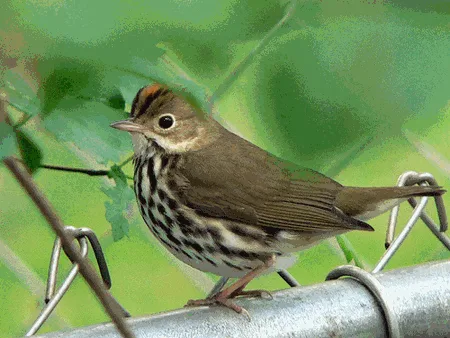
Ovenbird
[order] PASSERIFORMES | [family] Parulidae | [latin] Seiurus aurocapilla | [UK] Ovenbird | [FR] Sylvette couronnee | [DE] Pieper-Waldsanger | [ES] | [NL] Ovenvogel
Subspecies
| Genus | Species | subspecies | Breeding Range | Breeding Range 2 | Non Breeding Range |
| Parkesia | aurocapilla | ||||
| Seiurus | aurocapilla | NA | n, c, e | MA, West Indies, n SA | |
| Seiurus | aurocapilla | aurocapilla | |||
| Seiurus | aurocapilla | cinereus | |||
| Seiurus | aurocapilla | furvior |
Physical charateristics
Quite large, terrestrial Nearctic wood warbler, with thrush-like plumage: crown striped orange in centre and black on sides, bold white eye-ring, olive upperparts, and heavily spotted and streaked underparts.
Listen to the sound of Ovenbird
[audio:http://www.aviflevoland.nl/sounddb/O/Ovenbird.mp3]
Copyright remark: Most sounds derived from xeno-canto
| wingspan min.: | 22 | cm | wingspan max.: | 26 | cm |
| size min.: | 14 | cm | size max.: | 16 | cm |
| incubation min.: | 11 | days | incubation max.: | 14 | days |
| fledging min.: | 8 | days | fledging max.: | 14 | days |
| broods: | 1 | eggs min.: | 4 | ||
| eggs max.: | 6 |
Range
North America : North, Central, East
Habitat
Breeds in temperate Nearctic lowlands, in woodlands, foraging on forest floor. Favours well-drained bottomland, deciduous forest, not too thick with undergrowth. In winter in South America, inhabits deciduous forest, forest edge, and other wooded areas near sea-level.
Reproduction
During courtship, the birds begin to sing and the male dashes about, rises high and flutters down toward his prospective mate who sits in silence. The male then drops beside her and gives a series of hops and droops his head and tail while elevating his wings. The ovenbird receives its name from its oven like nest. The nest is normally always on the ground and is formed from dry leaves, decayed moss and grasses. The nest is covered by a dome of leaves, twigs and grasses and resembles a Dutch oven. A small entrance, just large enough to admit the bird, is left on one side. The female builds the nest. The female lays 4 to 6 eggs during the months of May-July that are white and irregularly spotted with reddish-brown near the large end. The eggs are subject to predation by snakes, squirrels and skunks. Incubation is done by the female and eggs hatch in 11-14 days. The young bird’s eyes are closed at birth and open by the 5th day. Both male and female feed the young. First flight is in 8 to 11 days.
Feeding habits
The ovenbird is somewhat unique among songbirds in that it walks on the ground and feeds on crickets, ants, spiders, caterpillars, aphids, earthworms, moths, slugs and beetles that it finds when turning over leaves with its bill. It also occasionally feeds on seeds and fruit.
Conservation
This species has an extremely large range, and hence does not approach the thresholds for Vulnerable under the range size criterion (Extent of Occurrence <20,000 km2 combined with a declining or fluctuating range size, habitat extent/quality, or population size and a small number of locations or severe fragmentation). The population trend appears to be stable, and hence the species does not approach the thresholds for Vulnerable under the population trend criterion (>30% decline over ten years or three generations). The population size is extremely large, and hence does not approach the thresholds for Vulnerable under the population size criterion (<10,000 mature individuals with a continuing decline estimated to be >10% in ten years or three generations, or with a specified population structure). For these reasons the species is evaluated as Least Concern.
Breeds in North America from north-east British Columbia and southern Mackenzie east to Newfoundland, south to eastern Colorado, eastern Oklahoma, northern Alabama, and South Carolina. Accidental. Britain: Shetland, October 1973; Devon, freshly dead, October 1985; Merseyside, tideline wing found, January 1969. Ireland: Lough Carra forest (Mayo), freshly dead, December 1977; Dursey Island (Cork), September 1990.
Breeds in North America from north-east British Columbia and southern Mackenzie east to Newfoundland, south to eastern Colorado, eastern Oklahoma, northern Alabama, and South Carolina. Accidental. Britain: Shetland, October 1973; Devon, freshly dead, October 1985; Merseyside, tideline wing found, January 1969. Ireland: Lough Carra forest (Mayo), freshly dead, December 1977; Dursey Island (Cork), September 1990.

Migration
Migrant. Breeding and winter ranges approach within 200 km in south-east USA, but most birds migrate over 1000 km. Winters mainly Florida, West Indies, and from northern Mexico south to Panama. Migration on broad front in both seasons, mainly east of Rockies, and from eastern Mexico to southern Florida.
Distribution map

